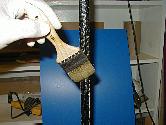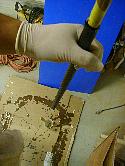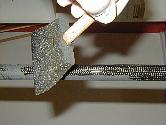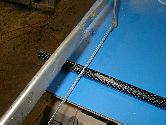
 |
||||
| INDEX | next |
 |
Slide the whole thing in. |
 |
6. Streatch and tighten " vis-à-vis Chinese finger trap". The sock squeezes the dry lay-up perfectly and concentrically around the mandrel and adjusts to the exact diameter. |
 |
7. Now, all the layers in the lay-up are dry and will need to be saturated by epoxy - completely! Select the thinnest and slowest setting epoxy available to you, warm it up and brush it on. I am using WS207 which is neither. Fortunately, carbon is very 'epoxy-phyllic' so the fibers like to draw the epoxy inside by cappilary action. See Epoxy Tests for epoxy inspiration. |
 |
8. Now, massage the epoxy into the rod. Give it a real workout so that the epoxy can penetrate all the way to the core. Once the epoxy hardens, clamp the tubing in a vice and pull off the tube. You will thank your bearing grease. |
 |
9. Wet sand the tube and apply more epoxy filler coats. After the final wet sanding, give it a protective coat of varnish or polyurethane. |
 |
10. Chop to desired length. |
 |
11.
Dip in Plasti dip. A nice, clean and contrasting finish handle is born.
It is also very strong and feather light. You can also easily make graphite lashing hooks and kayak hardware by compression molding. |
| INDEX | next |
| Home | Kayak Designs | Kayak Shop | Materials | Kayak Gallery | About us |
| Building Manual | Plans | Sandwich Core | Wood Kayak | Order | |
| Epoxy Test | Abrasion Cloth | Rudder | Resources | Choosing Kayak | Guestbook |
If you notice any problems with the site (i.e. error links, missing images) please, let me know. Thanks
Mail:
Vaclav Stejskal
58 Wood Ln.
Acton, MA 01720
USA
Tel: 781-481-9261
© 1999
- 2024 Copyright Vaclav Stejskal
All rights reserved
Last page update:
9 May 2024